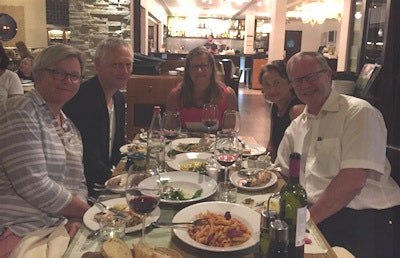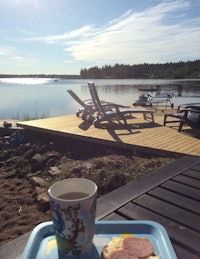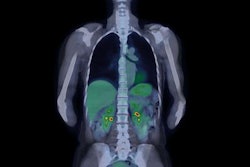
Outside of radiology, Dr. Katrine Åhlström Riklund, PhD, loves nothing more than boating, barbecuing, and creating new facilities at her family summer house. But next week she will enter virgin territory when the European Society for Hybrid Medical Imaging (ESHI) is officially launched at ECR 2016, of which Riklund is president.
Riklund is a radiologist who is also licensed in nuclear medicine at the University Hospital of Umeå in Sweden. She is deputy head of the department of radiation sciences and director of the medical school at Umeå University. In this interview, she speaks about her hospital and her enthusiasm for greater collaboration between radiology and nuclear medicine, as well as her personal hopes and expectations for the congress in Vienna.
 The composition of the program planning committee for ECR 2016 (shown here) was proposed by Riklund, who then asked for validation from the ESR Congress Committee. All images courtesy of Dr. Katrine Åhlström Riklund, PhD.
The composition of the program planning committee for ECR 2016 (shown here) was proposed by Riklund, who then asked for validation from the ESR Congress Committee. All images courtesy of Dr. Katrine Åhlström Riklund, PhD.AuntMinnieEurope.com: What can you tell us about the University Hospital of Umeå?
Riklund: It delivers highly specialized healthcare for northern Sweden. The catchment area covers half of the country but only 10% of the inhabitants. The number of beds does not describe the size of the hospital accurately because we have a well-developed concept of sending patients to their home hospitals as soon as possible after treatment.
There are about 5,600 staff working at the hospital and 4,500 at Umeå University, which is in the direct vicinity. The hospital is one of eight university hospitals in Sweden with responsibility for education of medical students, nurses, and other professionals in healthcare.
Are radiology and nuclear medicine a single department, or are the units run separately?
We only have one department for imaging, including diagnostic and interventional radiology, mammography, and nuclear medicine. In the hospital department, we have 270 staff, and in the university department of radiation sciences, we have around 70 people. The hospital department is located in three different hospitals, with approximately 130 km distance between each of them. Nuclear medicine is only located at the University Hospital in Umeå.
The equipment is all up to date with five CT systems (one dual source), five MR units (two 3 tesla), three SPECT/CT scanners, one PET/CT machine, and one PET/MRI system run in collaboration with radiation oncology. All nuclear medicine physicians are dual-licensed in radiology and nuclear medicine, and overall the level of collaboration is very well developed. About 85% of PET/CT examinations are performed using an optimized diagnostic CT protocol, which means the patient does not have to undergo a standalone CT. Furthermore, we have a 16.5-MeV cyclotron and radiochemistry laboratory for tracer production.
Approximately 125,000 examinations and mammography screenings are carried out annually. Of these, 4,000 are nuclear medicine examinations, mainly hybrid imaging. About 25,000 CT and 10,000 MR examinations, and 1,000 interventions are performed annually.
 Riklund (center) enjoys a pleasant dinner with colleagues during a Swedish Faculty of Nuclear Medicine course held on 1 October 2015. Also shown (from the left) are: Cathrine Jonsson, PhD, radiation physicist, Karolinska, Solna; Dr. Jens Sörensen, physician, Uppsala; Rimma Axelsson, physician, Karolinska, Huddinge; and Dr. Bengt Holmberg, physician, Linköping.
Riklund (center) enjoys a pleasant dinner with colleagues during a Swedish Faculty of Nuclear Medicine course held on 1 October 2015. Also shown (from the left) are: Cathrine Jonsson, PhD, radiation physicist, Karolinska, Solna; Dr. Jens Sörensen, physician, Uppsala; Rimma Axelsson, physician, Karolinska, Huddinge; and Dr. Bengt Holmberg, physician, Linköping.How have you developed and built up your department? What new equipment will come on stream this year?
We have built up the department over time. It became paper-free in 2000 when we installed the PACS/RIS, which means we can work seamlessly over the entire region. We also have a well-developed system for teleconferencing, which is heavily used for all multidisciplinary conferences for the entire northern region.
For hybrid imaging, the build-up is a long process. For PET/CT, we started with a mobile device in 2005, and FDG (fluorodeoxyglucose) was delivered from Finland. In 2010, a new building was completed and the on-site PET/CT and cyclotron were installed. In 2014, the PET/MR system was installed after a large donation from Cancerforskningsfonden in Norrland.
For hybrid imaging, my goal is for it to be used as a real integrated modality, and for that a lot still needs to be done. For instance, radiographers need more education in both nuclear medicine and in radiological imaging -- and they all have some knowledge already. It also means the physicians need education in both nuclear medicine and radiology -- which they already have, because all are double licensed. Continuous education is needed as well as awareness of the development of the area, and we must try the best we can.
What -- and whom -- inspired you to become a radiologist?
When I started in medical school, I wanted to become a surgeon, but during an elective in radiology in Saskatoon, Canada, I changed my mind. The head of department, Dr. C. Stuart Houston, and his colleagues, inspired me so much that I changed my mind and decided to be a radiologist -- a decision I have never regretted.
During the rest of my time at medical school, I started my thesis on radiology with a strong focus on nuclear medicine (radiolabeled monoclonal antibodies for diagnosis and therapy). At that time, I even thought nuclear medicine was one of the modalities of radiology. My PhD tutors were Dr. Sven-Ola Hietala, professor emeritus in radiology, and Dr. Torgny Stigbrand, professor emeritus in immunology. Dr. Ulf Stendahl, professor emeritus in ob/gyn, taught me a lot about science, and in fact, I have been working on research since my first day in the department. The possibility to understand more about diseases and treatment effects by different types of molecular and structural imaging inspires me every day.
 Riklund was a guest speaker at the Hong Kong international cancer congress in 2013.
Riklund was a guest speaker at the Hong Kong international cancer congress in 2013.What is your main area of expertise and special interest?
Without doubt this is hybrid imaging. I got involved in it at medical school when starting my PhD thesis work. Hybrid imaging with PET/CT is mainly used for oncology diseases. Besides that, I have a great interest in the neurotransmitter dopamine. This transmitter is involved in cognition and movement disorders. Our research in this field covers the spectrum from normal aging to dementia, including movement disorders.
What do you consider to be the single most important challenge facing radiology in Europe?
There are increasing requests for imaging. Methods are becoming more and more advanced, creating an increased amount of image data. The image data are complex and contain a lot of information we do not use yet, and in most of the science we lack information from tissue analysis, such as histopathology and omics-data. The challenge is to connect the image data to other types of data. We will also need to use big data analyses and computer-based analyses. At the same time, there are also more requests for conventional examinations. One challenge is therefore to retain and develop competence.
For ECR 2016, what is your main hope?
I hope a lot of radiologists, nuclear medicine physicians, radiographers, physicists, and other professionals will visit the congress. I hope they go home feeling they have learned something and they are convinced that radiology is the best thing to work with.
What's new this year compared with ECR 2015?
We have kept the best from previous ECRs, which is a lot. One new aspect is the "Voice of EPOS," where you can listen to poster sessions in several languages. Another thing is an increased amount of hybrid imaging content, which is close to my heart. There is also other news you will find out when you are there!
Which three sessions are you most looking forward to?
It is almost impossible to pick out three particular sessions because there are so many I would like to attend, so I will pick three types of sessions instead. I like the interactive sessions because they give you a possibility to get involved. I always look forward to the honorary lectures because they always bring in something new and a lot of front-line science. As the third type, I will choose the E3 Academies, in which you can take part of a comprehensive educational program.
 Riklund unwinds by spending time at her family summer house.
Riklund unwinds by spending time at her family summer house.If you were organizing ECR 2016 from the start again, what would you do differently?
There are always things you can do in a different way, but the organization of the ECR has been refined over decades and it works very well. I must say I would be confident of doing everything exactly the same way again. An important issue is to make sure the input from all working groups is done properly and all involved must understand the power of their contribution.
How do you relax when you are away from the hospital?
My hobbies outside of radiology are often radiology and nuclear medicine! But I do have other hobbies as well. I like to be at our summer house with family and friends: boating, barbecuing, and creating small buildings needed at a summer house. During wintertime, I love downhill skiing and try to at least like cross-country skiing. Finally, the best thing outside work is to be together with my lovely family.



















